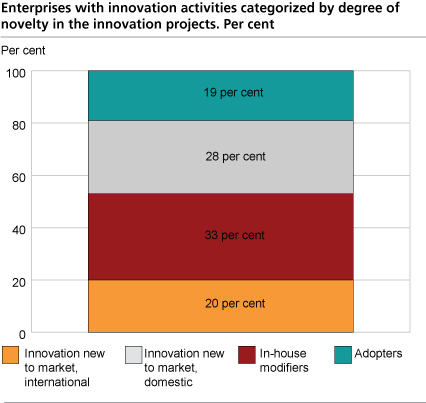Content
Published:
This is an archived release.
One in five enterprises is innovative
Slightly more than one in five enterprises has introduced product or process innovations, according to the 2006 Innovation survey. There are, however, large differences between industries and enterprise size.
An enterprise is considered innovative if it has introduced new or significantly improved products or processes during the last three-year period. For the business enterprise sector seen as a whole, 21 per cent of all enterprises are innovative. The reported innovation activity in the sector is thus stable, compared to the results of the 2004 survey.
Large enterprises more innovative
Innovation frequency increases with enterprise size. While 60 per cent of the largest enterprises - those with at least 500 employees - are innovative, only 16 per cent of the smallest enterprises - those with 5-9 employees - introduced new products or processes. Although the smallest enterprises introduce innovations much less frequently than larger enterprises, their contribution should not be underestimated.
The size factor is particularly evident in the mining and manufacturing industries. 84 per cent of the largest enterprises are innovative compared to 24 per cent of the smallest enterprises. The difference is slightly less pronounced in the service industries.
The differences in innovation activity between firms of different sizes may have several explanations. First of all, large enterprises generally have greater financial and human resources. Secondly, larger enterprises have a broader product range and more production processes, increasing the possibilities for innovation in at least one field.
Different types of innovators1
Some enterprises are market leaders and present products that are unique on the world market. Others develop their own products, which are new only on a local or domestic scale, or are similar to other available products. Some outsource the development of their innovations to others, or mainly copy existing products or processes.
The most original innovators - those which introduced innovations that were new to an international or domestic market - make up over half of the enterprises with innovation activities. 20 per cent introduced innovations that were new to the international market, while one in three introduced innovations that were new to the domestic market. Almost half introduced innovations that were less original than the abovementioned. 28 per cent developed new products or processes, but the innovations were not new to the market. The least original innovators make up 19 per cent. These enterprises reported that their new products and processes were mainly developed by others, and were not new to the market.
Innovations which are new to the market are equally common in mining and manufacturing as in the service industries. In both main industries, 55 per cent of the enterprises with innovation activities have introduced innovations which are new to the international or domestic market.
Within the mining and manufacturing industries, however, there are large differences according to size and large enterprises are more original than small enterprises. While 72 per cent of largest manufacturing enterprises with innovation activities introduced products or processes that were new to the market, only 46 of the smallest did so. The differences are less evident in the service industries. Here, 64 per cent of the largest and 53 per cent of the smallest enterprises introduced innovations that were new to the market.
What hampers innovation?
High costs are the single factor which most frequently hampers innovation projects in Norwegian enterprises - 54 per cent of the enterprises report that too high innovation costs were of high or medium importance for hampering the innovation activities. Other financial obstacles, such as the lack of internal or external funding, are also frequently cited. Many enterprises (43 per cent) report having problems recruiting or keeping qualified personnel. This is a much higher share compared to the last innovation survey, and is probably due to the long period of strong economic growth and the tight labour market in Norway.
Innovation also in organisation and marketing
Changes in organisation and market adjustments are not covered by the traditional innovation concept, but many enterprises are innovative in manners beyond the strictly technological. 21 per cent of all enterprises have carried out innovative changes in their market adjustments. Most frequently reported are changes in marketing strategies and sales to new customer groups or market segments, followed by significant changes in design and altered routines for product promotion.
Enterprises with 20 employees or more were also asked about significant organisational changes. 29 per cent had introduced organisational innovations. Most frequently reported are significant changes in the management structure or the organisational structure.
The survey shows that organisational and marketing innovations are primarily introduced by enterprises involved in product or process innovation. Moreover, large enterprises are much more often involved in these types of innovation as well, than are smaller enterprises.
The innovation survey is carried out every two years. Its purpose is to map the extent of innovation in Norwegian business and industry, and to identify factors that are important in the innovation process. The survey is part of Eurostat’s Community Innovation Survey (CIS2006). Extended results including regional results and comparisons with other EEA countries will be published at a later date.
1The categories apply to enterprises with innovation activities . Innovative enterprises and enterprises with innovation activities are defined differently see About the statistics .
Tables:
- Table 1 Enterprises with innovation. Per cent of population, 2006
- Table 2 Enterprises with innovation, by NACE. Per cent of population. 2006
- Table 3 Enterprises with innovation activities categorized, by degree of novelty in the innovation projects. 2006
- Table 4 Factors hampering innovation activities for units with innovation. The share of innovative enterprises reporting the factor in question to be of high importance, by size group. 2006
- Table 5 Innovative enterprises. Per cent of enterprises with 10 or more employees, 2001-2006
Contact
-
Lars Wilhelmsen
E-mail: lars.wilhelmsen@ssb.no
tel.: (+47) 40 90 24 35


